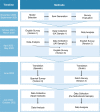Development and validation of the MosquitoWise survey to assess perceptions towards mosquitoes and mosquito-borne viruses in Europe
- PMID: 38245571
- PMCID: PMC10799950
- DOI: 10.1038/s41598-024-52219-9
Development and validation of the MosquitoWise survey to assess perceptions towards mosquitoes and mosquito-borne viruses in Europe
Abstract
Due to climate change and the expanding geographical ranges of key mosquito species, several mosquito-borne viruses (MBVs) have recently emerged in Europe. Understanding people's perceptions and behaviours towards these viruses and the mosquitoes capable of transmitting them is crucial for implementing effective prevention measures and targeted communication campaigns. However, there is currently no appropriate validated survey for European populations to assess this. This study developed and validated a standardized survey, based on the Health Belief Model (HBM), to assess perceptions of mosquitoes and MBVs among Europe's residents. The survey was distributed online to United Kingdom (UK), Dutch and Spanish participants through panel providers. Survey validity and reliability were tested using confirmatory factor analysis (CFA) and Cronbach's alpha. The optimised survey was completed by 336 UK, 438 Dutch and 475 Spanish residents, respectively, and the HBM items passed our validity and reliability testing in all three countries. The final survey has 57 questions, including 19 validated HBM items, and questions to assess demographic characteristics, knowledge, prevention measures and behavioural determinants. Our MosquitoWise survey bridges researchers' understandings of European residents' perceptions and knowledge as a first step to improve preventive behaviour towards mosquitoes and MBVs and guide prevention and communication initiatives.
© 2024. The Author(s).
Conflict of interest statement
The authors declare no competing interests.
Figures


References
MeSH terms
LinkOut - more resources
Full Text Sources
Medical

